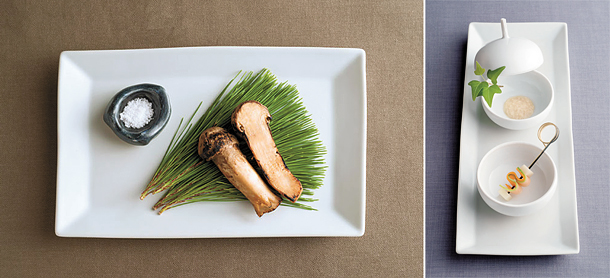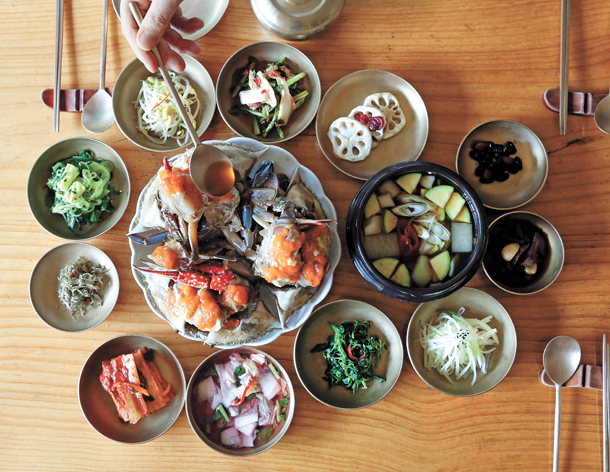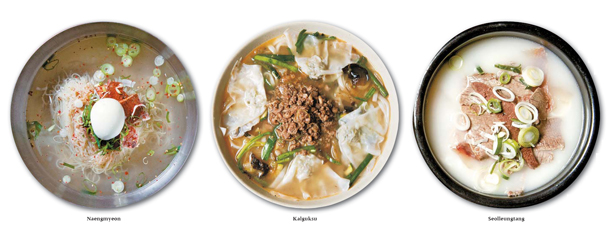Modern, simple dishes define new era of hansik: Fresh Korean food trends emerge after the Michelin Guide makes Seoul debut

Some of the dishes featured at Balwoo Gongyang, a restaurant that serves temple food that excludes meat, seafood and some spices, includes ingredients that are known to enhance power such as garlic and onions. The restaurant recently received one star from the Michelin Guide Seoul, a local edition of the globally renowned restaurant reviews by French tire company Michelin. [BALWOO GONGYANG]
Although the arrival of the globally renowned restaurant reviewer the Michelin Guide to Seoul early this month has spawned many debates over whether the starred restaurants deserved to be recognized among locals, it is undisputable that it can provide a sense of direction for visiting foreigners looking to enjoy what food the city has to offer.
The list comes in handy especially for short-term travelers who land in Incheon with no idea of where to start and may not be familiar with either the Korean dining scene or Korean cuisine, as there have been limited amounts of all-inclusive reviews of local restaurants written in English.
Korean food, because of the heat one can easily taste while eating kimchi, has long been categorized as spicy with its reliance on the red pepper sauce called gochujang, although it is also known for other meat dishes like bulgogi (marinated beef) and Korean barbeque. The Michelin Guide provides an opportunity for Korean food to show its dynamism with dishes without much spice now getting attention thanks to the global authority choosing many restaurants that specialize in lesser known styles as their recommended spots.
The four major trends that have emerged from the distinguished global guide are: modern Korean, which uses Korean ingredients but presents the food in a more modern setting: gejang, raw crabs marinated in soy sauce, which has been chosen by many international media as one of the most challenging food to eat: cold and warm soup that is served with either noodles or rice: and food enjoyed by monks at temples, which is known to have a milder taste than everyday food.

Gejang, center, is presented with side dishes at Keunkiwajip in Jongno District, central Seoul. The restaurant was recently honored by the Michelin Guide Seoul, which was released on Nov. 7. [JOONGANG ILBO]
One of the trends that is undeniably “confirmed,” thanks to the Michelin Guide, is the recognition of the term “modern Korean.” The term has been widely used to describe newly opened fine-dining style restaurants trying to present local ingredients in a more modern setting over the past couple of years. But there has been much consternation among veteran chefs who have been cooking traditional-style Korean food for years over how they will reckon with the new style of presentation for dishes made with local ingredients as hansik.
“It has been true that industry people, even the owner chefs at those ‘modern Korean’ restaurants, have been very cautious about defining their cuisine as either Korean or something Western like French,” said Lee Yun-hwa, CEO of a local restaurant guide Diary R.
However, as the global authority in food business defines such cuisine as modern Korean, it seems like people now see it more as an extension of what makes Korean food. Along with the two restaurants that earned the top honor with three stars, Gaon and La Yeon, Kwon Sook Soo and Gotgan stand strong, winning the second highest honor. Mingles, Jung Sik Dang and Soigne, all of which are known to serve more of a modern style Korean food were awarded one star. Some experts might say that one is more Korean than the other, but the presentation of the food all strays from the “traditional” presentation, which gives diners every dish at once on the table.
Even international food aficionados have been making reservations at these restaurants and managers are looking forward to the influx of reservations in the upcoming weeks. Thanks to locals who do not mind splurging on fine dining, these restaurants also see almost a full house every day of the week. These restaurants serve only course menus so that chefs can juxtapose one dish inspired by Korean ingredients among other dishes of different cuisines within one course.
To make this newly stylish food more affordable, Kwon Sook Soo is considering opening a more casual spot early next year, although a more detailed concept of the food to be offered has yet to be decided.

One of the most surprising things to many locals about the release of the starred restaurant list by the Michelin Guide was seeing the inclusion of Keunkiwajip, a restaurant in central Seoul known for its gejang. Although this dish is popular among locals, international media has shown diners struggling to get their heads around the blackened and raw seafood dish as it is rarely seen in other countries.
Raw crab is usually left in soy sauce for days until the crab meat gets infused with the sauce. The key here is not only to use very fresh crabs but also to use soy sauce that’s not too salty.
Although Keunkiwajip is the only place awarded a Michelin star, the Michelin Guide also listed two other gejang restaurants in Seoul including Jinmi Sikdang in Mapo District, western Seoul, and Hwa Hae Dang in Yeongdeungpo District in western Seoul.
Noodle soup, rice soup
While most in the food industry focused on the starred restaurant list, for everyday consumers looking to get their lunch and dinner on a budget focused their attention on the Bib Gourmand list, which shows restaurants worth a visit under a 35,000 won ($30) budget. The majority of the 36 restaurants listed make Korean dishes, such as mandu (dumpling), naengmyeon (cold noodle), kalguksu (flour noodle in beef or seafood broth) or seolleongtang (beef broth and rice) and some Korean barbeque spots.
What’s eye-catching here is that all of these Korean-style quick-bite restaurants serve mildly-flavored food as their signature dish rather than kimchi jjigae (kimchi soup) or deonjang jjigae (fermented soy bean paste soup), which are known to have stronger flavors.
“Of course all of these foods are what everyday Koreans would eat,” said Jinny Kang a local food critic.
“For those who have some experience eating Korean food will find these dishes new and fresh and definitely can expand their idea of what makes Korean cuisine.”
However, she also showed concern that the list might not be the best one to show those trying Korean food for the first time what defines the Korean cuisine.
“If the guide were to come out next year, it might be good for it to focus on introducing some more varieties as there are many other things that are widely enjoyed by not only Korean people but also foreigners who have spent a long time in Korea.”
“If I were a visiting foreigner, I think I would want to try what locals eat, not what is popular among visitors.”
Korean food found in nature
Since the guide honored a restaurant that specializes in temple food, vegetarians visiting Korea now have a must-visit option to add to their list of local restaurants. Temple food not only excludes meat and seafood from its courses, but some of the vegetables and condiments are known to create energy, such as onions, garlic, and scallions.
Without ingredients that give Korean food its distinctly strong taste, a discovery of milder Korean food continues. The simpler taste and presentation of the temple food has become popular thanks to local chefs trying to find their new weapon in an attempt to train themselves with new ideas that are less explored by others.
“The clean taste one can get from making vegetable broth has a different level of flavors one is used to getting from meat broth,” said chef Kang Min-goo of Mingles when he was presenting his vegetable ravioli in June in New York, in an attempt to explain what makes the flavors for the Korean cuisine.
With local chefs showing more interest, the Michelin Guide also saw the competitiveness that temple food can have in attracting visitors to Korea. Balwoo Gongyang, a temple food restaurant set up by the Jogye Order in Korea right across from the Jogye Temple in Jongno, central Seoul, has been awarded with one Michelin star.
“Eating what’s available in the season and finding out ways to live harmonious with nature is the basic idea behind temple food,” said Jeonggwan Sunim, who’s known as one of the experts in cooking temple cuisine. Thanks to the attention given to Korea’s temple cuisine, she has been building up relationships with many international big name chefs such as Eric Ripert of New York restaurant Le Bernardin, and become the voice of Korea’s temple cuisine. Most recently chef Shinobu Namae of Tokyo restaurant L’Effervescence also came to meet Sunim last month to put together a collaborative dinner with chef Kang Min-goo of Mingles over the weekend.
“Staying at a Korean temple was a different experience from visiting a Japanese temple,” said the chef adding that the Korean temple was more accommodating to ease him into the life there so that he could feel more relaxed. “I added [neungi] mushroom in the seasoning of my signature egg plant dish to incorporate [the comfort] I felt at the temple and present my experience on [a plate].”
Just as Jeonggwan Sunim mentioned, Balwoo Gongyang is now unveiling its new winter menu, in time for the change of season. Their winter menu includes dongchimi, white kimchi in cold broth, along with heavier dressings to seasonal veggies such as black sesame sauce or sesame doenjang (fermented soy sauce).
“Because we don’t serve any alcoholic beverages, we were more popular as a lunch spot, but after the Michelin [recognition], our tables are even filled for dinner almost everyday until the end of this year,” said Nam So-eun, assistant manager of Cultural Corps of Korean Buddhism’s communications department that represents the restaurant.
BY LEE SUN-MIN [summerlee@joongang.co.kr]










with the Korea JoongAng Daily
To write comments, please log in to one of the accounts.
Standards Board Policy (0/250자)